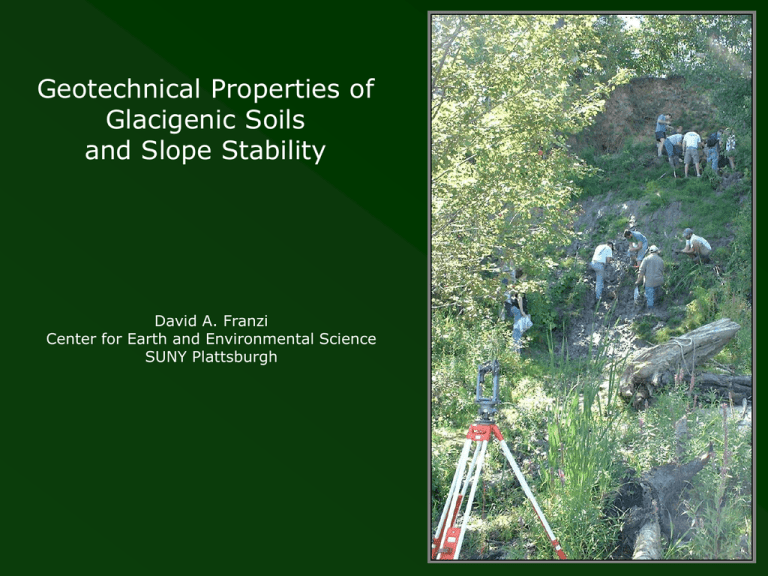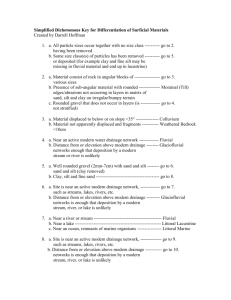Laboratory Exercises for Geotechnical Properties of
advertisement

Geotechnical Properties of Glacigenic Soils and Slope Stability David A. Franzi Center for Earth and Environmental Science SUNY Plattsburgh General Laboratory Format Skills and content exercises are organized around a central research question. • Introduction • Provide background information and references • Formulate hypotheses and experimental design • Articulate workload and final product expectations • Content and Skills Exercises (data collection & analysis) • Individual or small group assignments • Compilation of cohort database • Interim reports are due upon completion of each exercise • Capstone Exercise (synthesis) • Students are encouraged to discuss interpretations but writing is an individual effort • Emphasize connections between effective writing Laboratory Exercises for Geotechnical Properties of Soils and Mass Wasting Skills & Content Exercises • Morphometry (topographic mapping & cross sections) • Sediment Composition (mineral, chemical, and etc.) • Gravimetric Analyses • Particle Size Analyses • Atterberg Limits • Soil Classification • Hammer-Seismic Profiling • Shear Tests Capstone Exercises • • • • Soils as Engineering Materials Glacial Sedimentology and Stratigraphy Sediment Provenance Slope Stability Analysis Landslide Susceptibility Project Structure 1) Topographic and Geologic Survey (Weeks 1-2)* • • • Measure stratigraphic section Collect and prepare samples for gravimetric and particle-size analyses Produce a topographic map and geological cross-section 2) Gravimetric Analysis (Week 2) • • Lab analysis runs concurrently with topographic and geological survey exercise, data are reported with the particle-size analysis Determine volumetric water content, porosity and density of soil samples 3) Particle-size Analyses (Weeks 3 and 4) • • Content and Skills Sieve and hydrometer (or Coulter Counter) methods Compile hourly and daily databases 4) Atterberg Limits (Week 5) • Determine liquid and plastic limits on clay soils 5) Soil Classification (Week 6) • Classify soil types using the Unified Soil Classification – Synthesis 6) Slope Stability Assessment (Week 7) *Interim reports are submitted at the end of each exercise. These are edited and included as appendices in the final report Laboratory Exercises for Geotechnical Properties of Soils and Mass Wasting Materials and Supplies • • • • • • • • SoilTest Ely Volumeter Soil Test Torvane and pocket penetrometer Liquid-Limit cups Aluminum moisture cans Drying oven Balance (± 0.001 g) Standard surveying equipment Shear strength sampling materials and testing apparatus Example: Lake Champlain Landslide Susceptibility at the Plattsburgh Air Force Base Marina PAFB marina landslide NY North PAFB marina landslide 2 0 2 4 6 kilometers 8 10 100 0 100 meters 200 What factors control slope processes at the PAFB Marina? Contour interval = 1 meter 0 5 meters 10 Plattsburgh Air Force Base Marina Section West East 42 40 Elevation (meters) 38 laminated to thinly bedded marine sand and silt Champlain Sea water table springs 36 34 fossiliferous marine clay lacustrine varved clay Massive to ripple cross-laminated medium to fine sand Approximate extent of colluvium in 1996 Lake Vermont 32 30 diamicton Lake Iroquois breakout deposit colluvium Lake Champlain 28 limestone 0 5 Vertical Exaggeration = 2X Horizontal Scale (meters) 10 Gravimetric and Volumetric Data for Glacial Lacustrine and Marine Deposits at the Plattsburgh Air Force Base Marina Elevation at top of section = 42 meters a.s.l. Mass Moist Depth Below Top of Section (m) Sample Elevation (m) C1 12.0 30.0 95.15 C2 11.7 30.3 C3 11.1 C4 Mass Dry Mass of Can (g) Sample Volume (cm3) 81.92 37.80 29.15 95.16 81.89 38.05 29.15 30.9 96.00 82.60 38.13 29.15 10.6 31.4 95.75 83.70 36.57 29.15 C5 10.3 31.7 88.11 71.24 37.17 29.15 C6 9.7 32.3 85.59 69.47 38.21 29.15 C7 9.3 32.7 91.97 75.16 38.44 29.15 C8 8.3 33.7 92.12 77.43 38.14 29.15 C9 7.3 34.7 94.95 83.24 36.03 29.15 S1 6.4 35.6 98.91 88.12 38.25 29.50 S2 5.9 36.1 94.61 83.03 36.53 29.50 S3 5.3 36.7 97.36 85.88 38.16 29.50 S4 4.7 37.3 93.15 81.63 37.66 29.50 S5 4.1 37.9 93.66 81.75 36.32 29.50 S6 3.5 38.5 94.57 82.68 37.87 29.50 S7 2.9 39.1 83.90 75.19 30.00 29.50 S8 1.6 40.4 73.41 71.45 30.13 29.50 S9 0.7 41.3 71.80 70.92 30.19 29.50 Sample No. (Mass of Can + Soil + Water) (mass of can + soil) (g) (g) Plattsburgh Air Force Base Marina Section Particle Size Porosity (h), Vol. Moist. Cont. (q) Soil Density h rf 42 Elevation (meters a.s.l.) 40 generally unfossiliferous, thinly laminated laminated to to thinly thinlybedded, bedded, marine unfossiliferous fine sand , marine fine sandand andsiltsilt rsat rb Mean (1s error bar) q water table 38 36 34 32 fossiliferous, thinly laminated marine clay thinly laminated varved lacustrine clay medium sand calcareous till 0 8 (f) 16 0 20 40 (%) 60 1.0 1.4 (g/cm3) 1.8 2.2 Plattsburgh Air Force Base Marina Section Torvane Shear Strength Atterberg Limits Particle Size Water Content (%) 42 Elevation (meters a.s.l.) 40 generally unfossiliferous, thinly laminated laminated to to thinly thinlybedded, bedded, marine unfossiliferous fine sand , marine fine sandand andsiltsilt Mean (1s error bar) water table 38 36 34 32 wn fossiliferous, thinly laminated marine clay wLL wPL thinly laminated varved lacustrine clay medium sand calcareous till 0 8 (f) 16 0 20 40 (%) 60 0 3 (Kg/m2) 6 Plattsburgh Air Force Base Marina Section Chittick Carbonate Loss on Ignition 42 Elevation (meters a.s.l.) 40 Microfauna Total Total generally unfossiliferous, thinly laminated laminated to to thinly thinlybedded, bedded, marine unfossiliferous fine sand , marine fine sandand andsiltsilt Calcite Candona Forams LOI550 water table 38 LOI1000 12,990 cal. y.b.p. 36 fossiliferous, thinly laminated marine clay Dolomite 34 32 thinly laminated varved lacustrine clay medium sand 0 calcareous till 5 10 (%) 15 0 4 (%) 8 0 5 (specimens/gram) (3-pt avg., max = 10) 10 Railroad activity (ground vibrations?) and drainage diversions West East 42 40 Elevation (meters) 38 36 34 laminated to thinly bedded marine sand and silt water table Ground-water sapping at the base of the sand section fossiliferous marine clay lacustrine varved clay Weak, saturated clays Massive to ripple cross-laminated medium to fine sand Removal of lateral support by beach erosion 32 30 28 diamicton Lake Iroquois breakout deposit colluvium Seasonal & longterm controls on Lake Champlain water level limestone 0 5 Vertical Exaggeration = 2X Horizontal Scale (meters) 10 INSTRUCTOR JOINT STUDENT • Define learning objectives and skills • Set reasonable expectation levels • Pose the question • Provide background information and references • Familiarize yourself with the question – READ LITERATURE! • Articulate workload and final product expectations • Formulate hypothesis(es) • Design experiments • Define project focus • Plan field work • Assign working groups and tasks • Anticipate Contingencies • Data Collection • Data Analysis • Mentor and Advise Iterative Process • Data Synthesis • Assessment • Communicate Results Summary Advantages of Long-Term Projects • Provides time for students to reflect and contemplate their results–students receive feedback at interim steps; • Stimulates student interest and creativity; • Integrates skills and content from discrete exercises; • Links learning to real-world issues and problems; • Real data always produce unexpected teaching points that enhance the planned learning activity; • Engages students in all facets of a project (planning, execution and reporting); • Reinforces learning from other courses and experiences (e.g. knowledge of regional geology, effective writing mathematics, spreadsheets, and etc.); • Helps ease the transition from the mindset of student to professional geoscientist. Exportability • Site Availability May be a problem for some campuses but most activities can be derived from local consultant or municipal case studies. • Equipment Cost Small-scale projects can be implemented for several hundred to a few thousand dollars • Time Constraints Macomb Mtn. Landslide, Adirondack Mountains, NY Additional Slides Rethinking Class Time Applied Environmental Science Program SUNY Plattsburgh and The William H. Miner Agricultural Research Institute AESP Model: • Fall semester residential program featuring 5 inter-related, upper-division undergraduate environmental science and geology classes • Constructivist pedagogy; emphasis upon small-group, project-based learning • Day-long course format provides pedagogical flexibility that; • Creates an informal student-centered learning environment • Allows seamless integration of lecture instruction and field or laboratory projects • Facilitates inclusion of long-term projects • Increases effective geographic range for field excursions • Affords time for reflection and contemplation Slump at Whallonsburg, NY July, 1987 Oblique Aerial Photograph Toe of Slide – Bob Fuller for Scale Slump at Whallonsburg, NY July, 1987 Fissures in Overconsolidated Clays at Head Scarp Jack Ridge Sampling Clay at Head Scarp Toe of Secondary Slump




